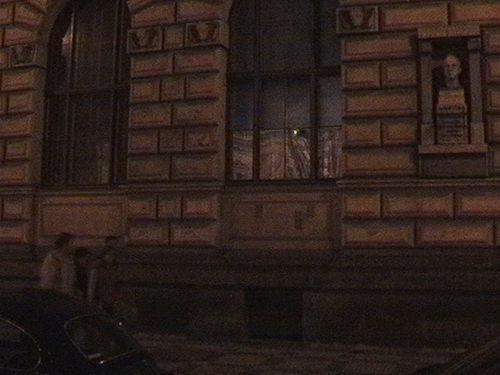12 September 2011 – 21 October 2011
Academy of Arts, Architecture and
Design in Prague
medium: interactive installation
dimensions: pavement, window
This is an interactive installation. When people would walk past the window at my university a sensor is triggered and a video of what could be happening inside starts to play. At the first year at university it was possible to be in the building late into the evening. Now it is not possible. This has been a problem for both teachers and students. This is a simulation of intimacy for the natural curiosity of by-passers. A project for the public spaces of the Academy of Arts, Architecture and Design in Prague, specifically the pavement along the facade of the AAAD by the windows of the sculpture studio.
The system reacts to people walking by the windows. When they walk by a window is lit up and a scene of a scenario which could be happening in the studio is projected. The scenes included a male student working on a painting, a female student putting on make-up and a group of friends talking to each other. The system will work the whole day, but will only react visibly at night – it is oriented according to the daylight.
The interactive installation consists of a projector, movement sensor and computer. The Kinect movement sensor collects information on the number of spectators walking past the AAAD and about the time they spend in front of it. In this way, statistics of the movement of spectators in front of the windows of the AAAD are generated and evaluated in the vvvv program.
AAAD public spaces
The purpose of the project is an artistic transformation of the public space immediately adjacent to the Academy of Art Architecture and Design in Prague (the pavement in front of the building, the area of Palach Square, the school facade, etc.) in the form of short-term installations and interventions by students of the school. In addition to this, the piece place with the run-down nature of the building. The space would gradually turn into an exhibition area, in which, not only during the closure period, outputs of individual studios and projects of students of the school would be presented.




